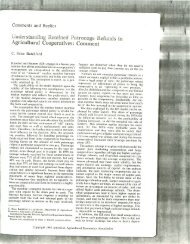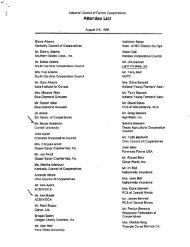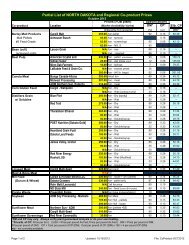Sunflower Production Field Guide - Your "Home Page"
Sunflower Production Field Guide - Your "Home Page"
Sunflower Production Field Guide - Your "Home Page"
Create successful ePaper yourself
Turn your PDF publications into a flip-book with our unique Google optimized e-Paper software.
30<br />
■ Wireworms<br />
Species: various<br />
Description: Wireworm larvae (Figure 18) are hard,<br />
smooth, slender, wirelike worms varying from 1.5 to 2<br />
inches (38 to 50 mm) in length when mature. They are<br />
a yellowish white to a coppery color with three pairs<br />
of small, thin legs behind the head. The last body segment<br />
is forked or notched.<br />
Adult wireworms (Figure 19) are bullet-shaped, hardshelled<br />
beetles that are brown to black and about ½<br />
inch (13 mm) long. The common name “click beetle”<br />
is derived from the clicking sound that the insect<br />
makes when attempting to right itself after landing on<br />
its back.<br />
■ Figure 18. Wireworm larvae. (Mark Boetel)<br />
■ Figure 19. Click beetle or adult wireworm.<br />
(Roger Key, http://www.insectimages.org)<br />
Life Cycles: Wireworms usually take three to four<br />
years to develop from the egg to an adult beetle. Most<br />
of this time is spent as a larva. Generations overlap, so<br />
larvae of all ages may be in the soil at the same time.<br />
Wireworm larvae and adults overwinter at least 9 to<br />
24 inches (23 to 61 cm) deep in the soil. When soil<br />
temperatures reach 50 to 55 F (10 to 13 C) during the<br />
spring, larvae and adults move nearer the soil surface.<br />
Adult females emerge from the soil, attract males<br />
to mate, then burrow back into the soil to lay eggs.<br />
Females can re-emerge and move to other sites, where<br />
they burrow in and lay more eggs. This behavior<br />
results in spotty infestations throughout a fi eld. Some<br />
wireworms prefer loose, light and well-drained soils;<br />
others prefer low spots in fi elds where higher moisture<br />
and heavier clay soils are present.<br />
Larvae move up and down in the soil profi le in<br />
response to temperature and moisture. After soil<br />
temperatures warm to 50 F (10 C), larvae feed within<br />
6 inches (15 cm) of the soil surface. When soil temperatures<br />
become too hot (>80 F, 27 C) or dry, larvae<br />
will move deeper into the soil to seek more favorable<br />
conditions. Wireworms infl ict most of their damage in<br />
the early spring, when they are near the soil surface.<br />
During the summer months, the larvae move deeper<br />
into the soil. Later as soils cool, larvae may resume<br />
feeding nearer the surface, but the amount of injury<br />
varies with the crop.<br />
Wireworms pupate and the adult stage is spent within<br />
cells in the soil during the summer or fall of their fi nal<br />
year. The adults remain in the soil until the following<br />
spring.<br />
Damage: Wireworm infestations are more likely to<br />
develop where grasses, including grain crops, are<br />
growing. Wireworms damage crops by feeding on the<br />
germinating seed or the young seedling. Damaged<br />
plants soon wilt and die, resulting in thin stands. In a<br />
heavy infestation, bare spots may appear in the fi eld<br />
and reseeding is necessary.<br />
Scouting Method: Decisions to use insecticides for<br />
wireworm management must be made prior to planting.<br />
No rescue treatments are available for controlling<br />
wireworms after planting. Producers have no easy







